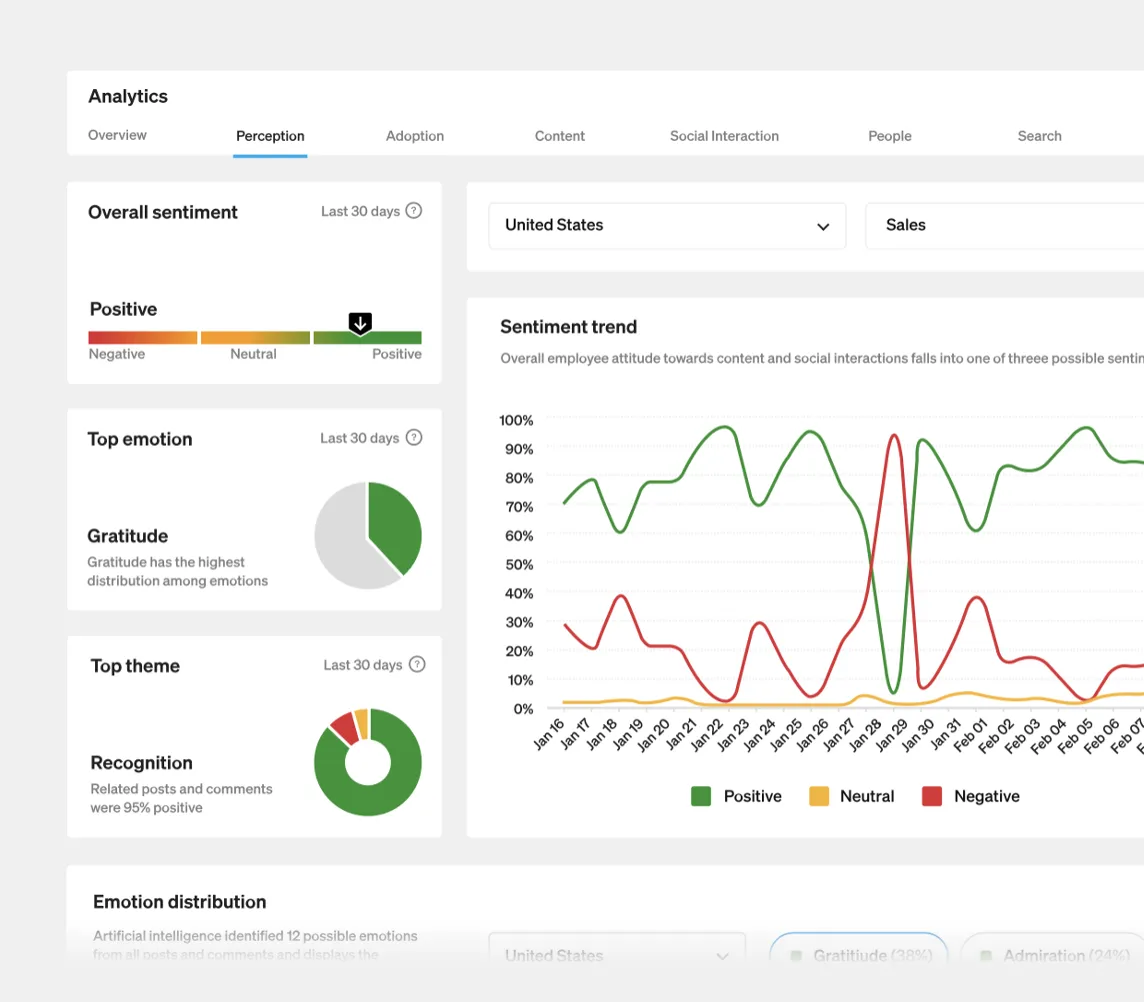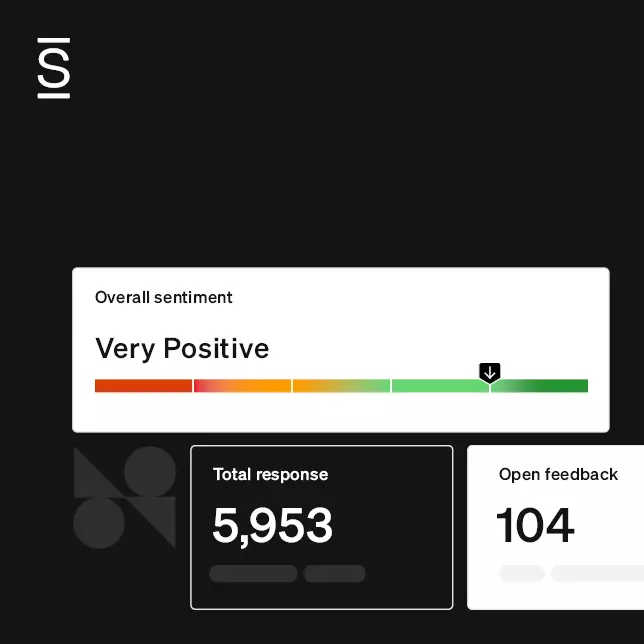Are you listening to your employees? Employee listening is a strategic investment that enhances employee well-being and also contributes to the organization’s long-term success. Effective employee listening strategies and programs can boost employee engagement, leading to improved morale and satisfaction.
But wait! Let’s be sure we don’t confuse employee listening with employee monitoring. There’s a clear distinction between the two.
Employee monitoring vs. employee listening
What is employee monitoring?
Employee monitoring refers to using technology, tools, and processes to observe and track various aspects of employees’ activities in the workplace. The goal of monitoring is ensuring employees follow company rules and policies by monitoring and collecting data on employee behaviors and interactions. It’s like having a surveillance system that monitors what employees are doing — commonly perceived as “big brother.” However, monitoring can be positive to the organization as well, such as enforcing important things like compliance and security.

Is someone doing something they shouldn’t be doing—something that can be scrutinized and punished? That’s what monitoring concerns itself with. This approach often creates tension, as it can lead to distrust and employees trying to hide their activities. In fact, Harvard Business Review found employee monitoring is more likely to make employees even break rules. Monitoring and measuring activity does not indicate employee productivity. For example, monitoring how much time an employee spends on their computer does not mean they were productive.
However, employee monitoring can be beneficial if used for the right reasons. For example, using monitoring to improve security by making sure everyone clocks out.
What is employee listening?
On the other hand, employee listening is all about understanding the employee’s point-of-view, removing the guesswork, and being proactive in making decisions that positively impact their overall employee experience. Unlike monitoring, employee listening involves creating communications channels between employees and leaders who proactively seek out employee feedback, such as thoughts, opinions, and ideas on how to improve aspects of their work environment.
Employee listening happens when you intentionally seek to understand employee concerns, suggestions, and experiences with a focus on improvement to the overall employee experience. Feedback is gathered anonymously and captured where your employees are, giving employees a direct line to communicate and share suggestions with managers. If managers don’t know what’s wrong, after all, they can’t improve.
When this insight is captured consistently and in real-time, an employee listening strategy is powerful as it allows you to respond to situations as they arise and make adjustments and course-correct before things become a bigger issue.

Why is employee listening important?
Employee listening is crucial for several reasons:
- Employee engagement lives here: By actively listening to employees, you demonstrate that their opinions and perspectives are valued. This fosters a sense of employee engagement and empowers employees to contribute their ideas and concerns, leading to higher job satisfaction, commitment, and innovation.
- Challenges and opportunities are identified: By listening to employees, organizations can uncover potential challenges and opportunities within the workplace. This valuable feedback can help identify improvement areas, whether addressing workflow bottlenecks, enhancing collaboration, or implementing new initiatives to boost productivity and improve workplace culture.
- Retention and morale are increased: When employees feel heard and understood, it positively impacts their job satisfaction and confidence. By actively addressing employees’ concerns and implementing improvements based on their feedback, organizations can significantly enhance employee retention rates, reduce turnover, and foster a positive work culture.
- Innovation and problem-solving increases: Employees often have unique insights and ideas to drive innovation and problem-solving within the organization. By actively listening to their suggestions and incorporating them into decision-making processes, companies can tap into diverse perspectives and improve their innovation ability.
- Trust and communication grows: Employee listening builds trust between employees and management. When a workforce feels their voices are heard, they are more likely to communicate openly, share ideas, and collaborate effectively. This open communication fosters a company culture of trust, transparency, and mutual respect within the organization.
Strategies for effective employee listening
Transparency is key
To successfully implement employee listening strategy in your company, transparency is key. Collecting data from your employees without their knowledge can cause legal problems and create trust issues. However, when you involve them in this process, they become more open to its benefits, strengthening the culture of trust and empowerment within your organization.
Address the feedback, not the identity
You should know that finding out who said what goes against the core principles of employee listening. Instead, the focus is on what has been said and how to take action based on that feedback. Unless there are exceptional circumstances, respecting anonymity and prioritizing addressing the feedback rather than identifying specific individuals is vital.
Focus on employee contributions
Gather information that helps you understand how well employees perform. Counting how many times an employee swipes something in a week doesn’t show productivity or engagement. Instead, focus on information directly reflecting their performance and contribution to the company’s success. With the help of prescriptive analytics, this approach guides you toward achieving your goals.
Use data to make intentional decisions
After listening to your employees and gathering their thoughts, put that information into action. Refrain from rushing to conclusions without understanding the insights properly. Take your time to get the full picture before making big decisions, like solving a puzzle with all the pieces.
And be aware of systemic constraints that can affect employees’ performance. For example, imagine having to complete a lot of paperwork daily. It takes up time and makes you tired. But using technology can streamline and eliminate those extra tasks and help employees work better.
Listen and get feedback from employees regularly
Regularly and consistently check how well your listening efforts are working. Evaluate and identify areas for improvement. This ensures that your strategies for listening to employees consistently improve and have the most impact.
Make employee listening a company-wide priority
It is crucial to emphasize the value of listening to your employees and to promote its value company-wide. When you prioritize listening, you create an environment that fosters unity and cohesion, and a culture where everyone can simply flourish. It is the best way to understand your employees’ needs, concerns, and ideas, empowering you to make positive changes that drive success.
Request a demo if you’re interested in further exploring how Simpplr Employee Listening can help improve employee engagement and organizational success.














